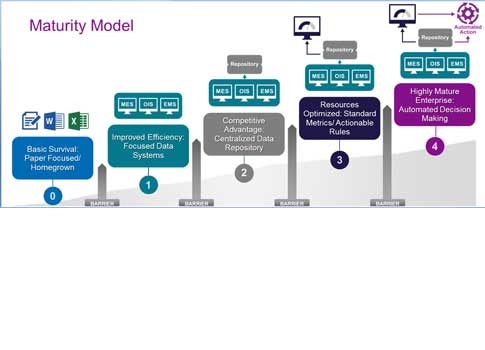Advance capabilities of enterprise information systems with the maturity model explanation provided. Decision efficiency is measured by the cost (money, time, and effort) to make a decision. Greater decision efficiency = lower costs = higher profits. Consider 5 factors when measuring decision efficiency.

Advance capabilities of plant floor and enterprise information systems by understanding and advancing within the maturity model, as explained here. Plant floor systems are complex. Enterprise plant floor systems are even more complex. These systems aim to help businesses make effective decisions that positively impact the bottom line. Unfortunately, managing systems across an enterprise, adopting emerging technologies, and ensuring financial viability aren’t easy tasks. To help put these challenges in perspective, considering the maturity model can help when managing and integrating enterprise information systems. Understanding concepts of the maturity model helps with managing and integrating enterprise system maturity. Increasing system maturity can increase profits.
The goal of the maturity model is to address the complexity of enterprise systems as you would any complex problem. It simplifies the problem into small, more manageable chunks. The model is based on the overall purpose of an information system: how well does it increase decision-making efficiency?
Measure decision efficiency 5 ways
Decision efficiency is measured by the cost (money, time, and effort) to make a decision. Simply put, Greater decision efficiency = lower costs = higher profits.
Consider at least five factors when measuring decision efficiency.
1. Operations management. This represents the amount of human effort needed to operate a system. Usually, manual effort is made more efficient through automation. (Manually processing paperwork versus computerized tabulation.) [bold]
2. Data collection. Data collection is the cost associated with obtaining information needed for business decisions. Similar to operations, automation is used to make data collection more efficient. (Manually typing in part counts versus automated data transfers from machining cells.)
3. Data distribution. The number of data storage locations that must be accessed to make a decision. The fewer places that data is stored, the more effective the data distribution. (Processing data from several production databases versus accessing a single, centralized database.)
4. Decision quality. This is the relative accuracy of the information and decision results: the better the accuracy, the better the quality. (Consistently revising production estimates because of bad data versus good estimates the first time.)
5. Sustainability. This is the cost required to support, change, expand, and maintain enterprise systems. The lower the cost, the better the sustainability is. (For example, that could mean having a dedicated system support staff for a standard platform versus only one person who can support a "one-off" application.)
Before defining a maturity model, remember that even with today’s technology and innovations, most systems rank low on the maturity scale. In fact, the number of systems is inversely proportional to their maturity level.
This isn’t an insult to the current state of our information systems. Rather, it points out an important fact: mature systems require a significant and carefully coordinated investment. Few systems reach the higher levels of maturity. But, the reward for the investment-efficient decision making that reduces cost and improves productivity-is worth the effort.
Why create a maturity model?
The maturity model presents a general context for understanding enterprise systems. First, it provides a set of criteria to evaluate enterprise system needs and help determine next steps to increase decision efficiency (and your bottom line). Second, it helps owners communicate more clearly with internal business units, integrators, and vendors.
Maturing model explanation
The model is applicable to any information system and production level process. When reviewing the model, envision a system for which you’re responsible. By the end of the article, it should be apparent where that system falls in the maturity model.
Maturity model levels 0 – 4 follow, with explanations.
Level 0 – basic survival: paper focused/homegrown
Level 0 is where most systems get their start. At this level, "system" is a loose term for activities and applications that help a company survive rather than prosper. A level 0 system is focused on solving one small-scoped issue. Initially, these systems start as paper-focused processes. Slowly, data collection and some processes are automated using homegrown applications. Often, these applications are built by process engineers or operations specialists who dabble in programming. Information systems are not their primary expertise. Also, the applications are built on readily accessible but general (ill-fitting) tools such as Microsoft Office products.
Systems at this level suffer from inefficiencies. Paper processes or homegrown applications focus on collecting information to help run the operation-not on making business decisions. The cost to manually gather and analyze data is a large part of the overall operational costs. Information is logged to paper sources and by different applications, making it difficult to use. And when things go wrong, there is often only one person (the one who wrote the application or fully understands the process) who can fix it.
Level 1 – improved efficiency: focused data systems
Level 1 maturity is an important step for a company. It represents a strategic decision to move away from survival mode to a formal information system. Companies form partnerships with system integrators that provide tailored solutions using common-off-the-shelf (COTS) software. For real-time, plant-floor applications, customers often choose a supervisory control and data acquisition (SCADA) software that provides a standard and supportable platform.
Each individual system becomes highly efficient for its specific task. Data collection is automated, paper processes are retired, and manual operations are reduced. The team dedicated to running the system uses metrics (such as overall equipment effectiveness) to understand how operations are performing. These data systems significantly improve production and reduce costs by enabling effective decision making in focused but separate areas.
The inefficiencies at level 1 become apparent when corporations attempt to combine information from these dedicated systems to make business decisions. Typically, each system stores its information differently. And the manual costs involved in analyzing seemingly unrelated data do not justify the obtained results.
Level 2 – competitive advantage: centralized data repository
Businesses that reach this level have overcome the inefficiencies of Level 1 systems to gain a competitive advantage. It puts them in position to significantly increase their decision-making capability by making deep insights and correlations across the enterprise. Although this level doesn’t provide much direct output, it’s essentially the "heavy lifting" that enables the next level of maturity. It’s so important that it deserves its own maturity level.
Companies at this level focus on combining the information produced by systems across the enterprise to understand operations in real time. The organization shifts its focus from operating within independent silos to open data sharing and analysis. Information from dedicated systems is collected, cleaned, organized, and stored in a centralized location. The business establishes formal processes for new systems to provide information to the central repository. Some corporate metrics for understanding performance are used to make strategic business decisions. Usually, the first metrics are developed for government or other mandatory reporting.
Level 3 – optimized resources: standard metrics and actionable rules
At this level, the central data repository is leveraged to its fullest extent. The company invests in analytics applications that use standardized data to make highly efficient decisions that lower costs and create value throughout the organization.
The company makes key insights to help eliminate wasteful activities by connecting information across business operations. Teams develop standard metrics for managing all types of business aspects and directly tie them to success criteria. Business units are judged based on normalized comparisons. Managers and supervisors evaluate performance in real time.
Predictive and proactive analytics are modeled from the centralized data. Based on these analytics, business rules provide actionable information that is incorporated into the everyday activities of operational personnel. Enterprise dashboards allow these rules to be routinely updated to address specific efficiency issues, best practices, and poor performance.
Level 4 – highly mature enterprise: automated decision making
Level 4 of the maturity model creates an optimized business environment that uses real-time operational information to align employee activities with business goals. The last step of the maturity process is to automate fundamental decision-making processes. This allows personnel to redirect efforts from mundane tasks to efficiency-driven activities that continually improve operations and lower costs. At this level, enterprises rely on automated decisions to provide key benefits such as reject handling, work order generation, and supply chain management. Complex and crucial decisions incorporate authorization workflows that integrate directly with business systems.
What’s next?
Ideally, the maturity model has helped determine where your systems are positioned in the maturity lifecycle. After knowing the "what" of the maturity model, later articles will focus on "how," that is, how a company can overcome the hurdles to move up the maturity model.
– Corey Stefanczak is senior system architect, Leidos. Edited by Mark T. Hoske, content manager, CFE Media, Control Engineering, [email protected].
ONLINE
www.controleng.com/archives under August, read this article online for more information and links to related articles on maturity models.
Key concepts
- Understanding concepts of the maturity model helps with managing and integrating enterprise system maturity.
- Increasing system maturity can increase profits.
- The goal of the maturity model is to address the complexity of enterprise systems as you would any complex problem, by simplifying the problem into manageable chunks.
- Measure decision efficiency 5 ways.
Consider this
What goals can you attain more easily by moving to higher levels in the system maturity model?
ONLINE extra
See other article about the value of advancing in the maturity model and articles about how it has been applied to green/sustainability/energy-efficiency concepts as well as cyber security.
This article online contains links to each part of this full five-part series on meeting the challenges of enterprise information systems looking at the maturity model introduction, taking the first step, gaining a competitive advantage, optimizing resources, and a highly mature enterprise.
Part 1: Understand the maturity model to better manage, integrate plant floor, enterprise systems Control Engineering (CE), August issue, Inside Machines section, p. M1 [This article]
Part 2: Migrating toward enterprise information systems from Applied Automation (supplement to CE and Plant Engineering), October issue, p. A13
Part 3: Gain a competitive advantage, meet the challenges of enterprise information systems CE Weekly News enewsletter, Nov. 25
Part 4: Optimizing the climb up the enterprise information systems maturity model CE November issue, Technology Update, p. 34
Part 5: Highly mature enterprise: Meet the challenges of enterprise information systems CE December issue, Inside Machine section, p. IM4



